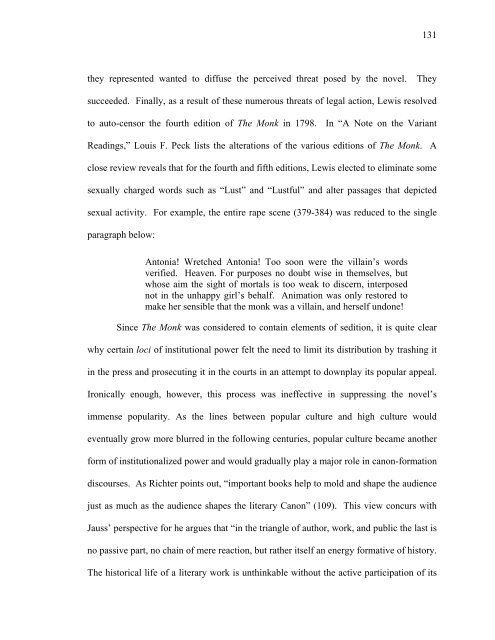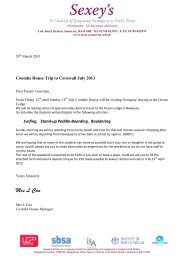Untitled - Sexey's School Moodle
Untitled - Sexey's School Moodle
Untitled - Sexey's School Moodle
Create successful ePaper yourself
Turn your PDF publications into a flip-book with our unique Google optimized e-Paper software.
they represented wanted to diffuse the perceived threat posed by the novel. They<br />
succeeded. Finally, as a result of these numerous threats of legal action, Lewis resolved<br />
to auto-censor the fourth edition of The Monk in 1798. In “A Note on the Variant<br />
Readings,” Louis F. Peck lists the alterations of the various editions of The Monk. A<br />
close review reveals that for the fourth and fifth editions, Lewis elected to eliminate some<br />
sexually charged words such as “Lust” and “Lustful” and alter passages that depicted<br />
sexual activity. For example, the entire rape scene (379-384) was reduced to the single<br />
paragraph below:<br />
Antonia! Wretched Antonia! Too soon were the villain’s words<br />
verified. Heaven. For purposes no doubt wise in themselves, but<br />
whose aim the sight of mortals is too weak to discern, interposed<br />
not in the unhappy girl’s behalf. Animation was only restored to<br />
make her sensible that the monk was a villain, and herself undone!<br />
131<br />
Since The Monk was considered to contain elements of sedition, it is quite clear<br />
why certain loci of institutional power felt the need to limit its distribution by trashing it<br />
in the press and prosecuting it in the courts in an attempt to downplay its popular appeal.<br />
Ironically enough, however, this process was ineffective in suppressing the novel’s<br />
immense popularity. As the lines between popular culture and high culture would<br />
eventually grow more blurred in the following centuries, popular culture became another<br />
form of institutionalized power and would gradually play a major role in canon-formation<br />
discourses. As Richter points out, “important books help to mold and shape the audience<br />
just as much as the audience shapes the literary Canon” (109). This view concurs with<br />
Jauss’ perspective for he argues that “in the triangle of author, work, and public the last is<br />
no passive part, no chain of mere reaction, but rather itself an energy formative of history.<br />
The historical life of a literary work is unthinkable without the active participation of its



